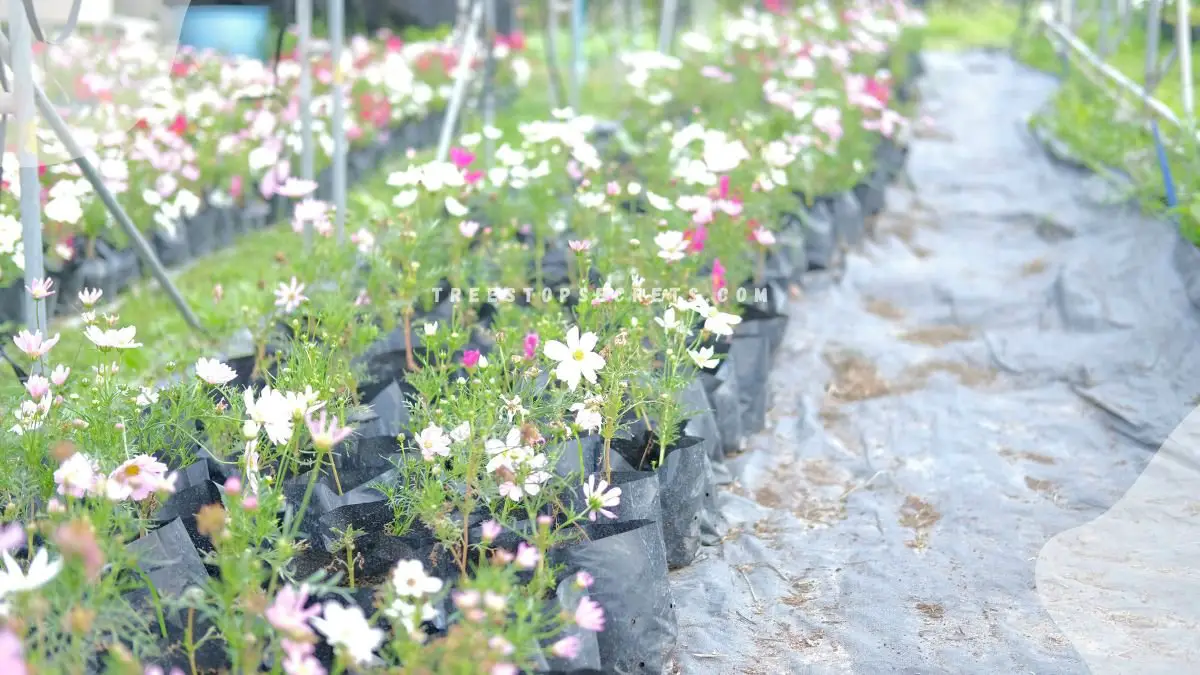Want to add a burst of color to your garden? Growing cosmos flowers could be the perfect solution. These vibrant blooms not only attract pollinators but also require minimal maintenance, making them ideal for both seasoned gardeners and beginners. With a rich historical background dating back to ancient times, cosmos flowers, a cherished plant, have been treasured for their beauty and symbolism. By learning how to grow cosmos flowers successfully, you can enjoy a stunning display of colorful petals that will brighten up your outdoor space throughout the growing season. Discover the secrets to cultivating these enchanting flowers and elevate your garden to new heights.
Key Takeaways
- Planting at the Right Time: Ensure to plant cosmos flowers during the spring after the last frost for optimal growth.
- Proper Care is Key: Regular watering, well-draining soil, and full sunlight are essential for the healthy growth of cosmos flowers.
- Explore Different Varieties: Experiment with planting various types of cosmos flowers like 'Sensation Mix' or 'Bright Lights' to add diversity to your garden.
- Maximize Flower Yield: Regular deadheading and pruning can encourage continuous blooming throughout the season.
- Harvesting and Saving Seeds: Collect seeds from mature cosmos flowers for future planting, ensuring a sustainable garden year after year.
- Prepare for Winter: Wrap up the season by cutting back plants, mulching, and preparing for the next growing cycle.
Discovering Cosmos Flowers
Vibrant Colors
Cosmos flowers come in a wide array of vibrant colors, including pink, white, and red. These colorful blooms can add a pop of brightness to any garden space by planting them. The diverse color palette of cosmos flowers makes them a popular choice for gardeners looking to create visually appealing landscapes.
Benefits of Attracting Wildlife Attracting birds, bees, and butterflies to your garden by planting cosmos flowers can have numerous benefits. These pollinators play a crucial role in the ecosystem by aiding in plant reproduction. Having these creatures visit your garden can create a lively and dynamic outdoor space.
Easy Growth from Seeds
Planting cosmos flowers from seeds is a straightforward process that even beginners can successfully accomplish. Sow cosmos seeds directly into well-drained soil after the last frost date has passed. Ensure the seeds are planted at the appropriate depth and provide adequate sunlight for optimal growth.
- Pros:
- Easy to grow from seeds
- Low maintenance plant
- Attracts beneficial wildlife such as bees and butterflies
- Cons:
- Can reseed prolifically if not deadheaded
- May require staking for taller varieties
Cultivation Tips
When planting cosmos flower seeds, choose a location that receives full sun for at least 6-8 hours per day. These plants thrive in warm weather and well-drained soil. Water newly planted seeds regularly to keep the soil moist but not waterlogged. Once established, cosmos plants are relatively drought-tolerant and do not require frequent watering.
Varieties and Maintenance
There are various cosmos cultivars available, ranging from the classic cosmos bipinnatus to unique plant varieties like chocolate cosmos. Each type offers its own distinct characteristics, such as flower color, height, and foliage. Proper maintenance of cosmos plants involves deadheading spent blooms to encourage continuous flowering throughout the growing season.
Best Time to Plant
Ideal Timing
Plant cosmos flowers after the last frost in your area. This usually falls between late spring and early summer, depending on the weather conditions. Ensuring the threat of frost has passed is crucial for the successful growth of cosmos.
Well-Draining Soil Cosmos plants thrive in well-draining soil, which prevents waterlogging and root rot. Sandy loam or loamy soil types are ideal for these flowers as they allow excess water to drain away, keeping the roots healthy.
Soil pH Levels
Cosmos flowers can tolerate a wide range of soil pH levels, typically between 6.0 and 8.5. However, they prefer slightly acidic to neutral soil conditions for optimal growth. Testing the soil pH before planting can help you make necessary amendments.
Planting cosmos flowers at the right time ensures they establish strong roots and bloom beautifully. Consider the local climate and soil conditions when planning your cosmos garden.
Step-by-Step Planting Guide
Outdoor Planting
To grow cosmos flowers outdoors, start by preparing a well-drained planting palette with rich soil. Plant the seeds about an inch deep into the soil, ensuring they receive ample sunlight.
Indoor Sowing
Before the last spring frost date, sow cosmos seeds indoors to give them a head start. Use biodegradable pots filled with seed-starting mix. Water the seeds lightly and cover them with plastic wrap to retain moisture.
Proper Spacing
When transplanting cosmos seedlings outdoors, ensure proper spacing between each plant. Spacing them adequately allows for better air circulation and prevents overcrowding, leading to healthier growth.
Growing and Care Tips
Deadheading for Prolonged Flowering
Deadheading is the process of removing spent flowers to encourage new growth and prolong the flowering period. When cosmos plants are deadheaded regularly, they redirect their energy into producing more blooms rather than setting seeds. This practice not only promotes continuous flowering but also helps maintain the plant's overall appearance.
Regularly inspect your cosmos plants for faded or wilting flowers. Use sharp scissors or pruning shears to snip off these spent blooms just above a set of leaves or buds. By deadheading, you can prevent the plant from going to seed prematurely and ensure a lush and vibrant display of flowers throughout the growing season.
Importance of Staking Tall Cosmos Plants
Tall cosmos varieties, such as Cosmos bipinnatus, often require staking to support their height and prevent them from bending or breaking under their weight. Staking tall cosmos plants is crucial to maintain their upright growth and prevent them from leaning or toppling over, especially in windy conditions.
To stake tall cosmos plants effectively, install stakes early in the growing season before the plants reach their full height. Place the stakes close to the main stem without causing damage and secure them with soft ties or twine. As the plants grow, gently tie them to the stakes at intervals to provide additional support and ensure they remain upright and sturdy.
Watering and Care Requirements
Proper watering is essential for the health and vitality of cosmos plants. These flowers prefer moderate moisture levels and well-draining soil to thrive. Water your cosmos plants deeply but infrequently, allowing the soil to dry out slightly between waterings to prevent root rot and fungal diseases.
In addition to watering, cosmos plants benefit from regular feeding with a balanced fertilizer to promote healthy growth and abundant flowering. Apply a water-soluble fertilizer every 4-6 weeks during the growing season, following the manufacturer's instructions for dilution and application methods.
Exploring Types of Cosmos
Regular Cosmos
Regular cosmos, also known as common cosmos cultivars, are a popular choice among gardeners for their vibrant colors and easy maintenance. These varieties of cosmos come in shades of pink, white, and maroon, adding a splash of color to any garden. Regular cosmos are versatile and can thrive in various soil types, making them suitable for both novice and experienced gardeners.
Cosmos Bipinnatus
Cosmos bipinnatus is one of the most well-known species of cosmos flowers. With delicate, feathery foliage and large, daisy-like blooms, cosmos bipinnatus adds an elegant touch to garden beds and borders. These flowers attract pollinators like bees and butterflies, enhancing the biodiversity of your garden. Cosmos bipinnatus varieties are available in a wide range of colors, including pink, purple, and white.
Cosmos Sulphureus
Cosmos sulphureus is another popular species of cosmos known for its bright and fiery hues of orange and yellow. These varieties of cosmos add a warm and cheerful vibe to any outdoor space. Cosmos sulphureus thrives in sunny locations with well-draining soil, making them ideal for summer gardens. Gardeners often stake cosmos sulphureus plants to support their tall stems and prevent them from bending or breaking.
Water Cosmos
Water cosmos, also referred to as cosmos species, are unique due to their preference for moist soil conditions. Unlike other cosmos varieties that prefer well-draining soil, water cosmos thrive near ponds or water features where the soil remains consistently damp. These cosmos species produce delicate blooms in shades of pink and white, creating a serene atmosphere in water gardens.
Young Cosmos Care
When planting young cosmos seedlings, ensure they receive an adequate amount of sunlight each day to promote healthy growth. Water young cosmos plants regularly, especially during dry periods, to help them establish strong root systems. As the plants grow taller, consider staking them to prevent them from drooping or bending under their own weight.
Pairing Cosmos Varieties
To create visually appealing flower beds, consider pairing different cosmos varieties with complementary colors and heights. For example, mix tall cosmos bipinnatus with shorter cosmos sulphureus varieties to add dimension and interest to your garden. Experiment with various combinations to find the perfect pairing that suits your aesthetic preferences.
Stages of Growth
Planting Seeds
Cosmos flowers begin their journey from tiny seeds, usually sown in the fall for a vibrant display in the following year. These seeds can be directly sown into garden beds or started indoors before transplanting outdoors.
Starting cosmos seeds indoors allows for better control over germination conditions and ensures a head start on the growing season. Once the danger of frost has passed, the seedlings can be transplanted into the garden beds for further growth.
Seedling Stage
During the early stages of growth, cosmos seedlings require consistent watering to establish strong root systems. It is essential to provide adequate sunlight for at least 6-8 hours a day to promote healthy growth.
As the seedlings develop, they will begin to form their true leaves and exhibit more vigorous growth. At this stage, it is crucial to thin out weaker seedlings to prevent overcrowding and ensure optimal spacing for each plant to thrive.
Blooming Flowers
Cosmos flowers typically bloom around 7-12 weeks after planting, depending on the variety and growing conditions. The plants will start producing an abundance of colorful blooms that attract pollinators like bees and butterflies.
To prolong the blooming period, deadheading spent flowers regularly is recommended. This practice encourages continuous flower production and prevents the plant from putting energy into seed development.
Maintenance Tips
Regularly fertilizing cosmos plants with a balanced fertilizer can help support healthy growth and abundant flowering. Watering should be done deeply but infrequently to encourage deep root growth and drought tolerance.
Mulching around the base of cosmos flowers helps retain moisture, suppress weeds, and maintain consistent soil temperatures. Providing support such as stakes or cages for taller varieties can prevent them from bending or breaking under the weight of blooms.
Harvesting Flowers and Seeds
Cutting Flowers
Cut flowers from cosmos plants when they are in full bloom to enjoy them indoors. Like flowers, cosmos blooms can last for several days in a vase. To cut the flowers, use sharp scissors and make clean cuts at an angle.
Collecting Seeds
Harvesting seeds from cosmos plants is essential for gardening enthusiasts who want to propagate them. Allow the flowers to wither and fade on the plant before collecting the seeds. The seeds are typically found in the center of the flower head.
Preventing Seeding
Prevent cosmos plants from going to seed if you want to maintain large flowers throughout the season. Deadhead spent flowers regularly to encourage continuous blooming. This process also prevents self-seeding, ensuring a tidy garden.
Maintaining Garden Beauty
To ensure a vibrant garden with cosmos flowers, focus on flower colors and varieties that complement each other. Plant cosmos alongside other colorful blooms like daisies to create a visually appealing garden. Consider using containers for cosmos in varying shades of pink, white, and yellow for a stunning display.
End of Season Care
Prepare Plants
When the cosmos season ends, prepare your plants for the upcoming season to ensure their health. Trim back any dead or dying foliage to promote new growth in the next season. Remove any weeds around the plants to prevent competition for nutrients.
Clean Garden
Cleaning up the garden after the cosmos season is crucial for maintaining a healthy garden environment. Clear out any debris, such as fallen leaves or branches, to prevent pests and diseases from lingering. Dispose of any plant material properly to avoid potential contamination.
Protect Soil
After the cosmos season, protect the soil by adding a layer of mulch around the plants. Mulching helps retain moisture, suppresses weed growth, and improves soil structure. Choose organic mulch like shredded leaves or straw for better results.
Divide and Transplant
Consider dividing and transplanting cosmos plants at the end of the season. This process helps refresh the plants and promotes healthier growth in the next season. Replant divided sections in well-draining soil with sufficient sunlight.
Prune Effectively
Pruning cosmos plants at the end of the season is essential for maintaining their shape and health. Cut back any leggy or overgrown stems to encourage bushier growth next season. Prune damaged or diseased parts to prevent further spread.
Summary
You've now learned all about growing cosmos flowers, from discovering their beauty to harvesting their seeds. By following the step-by-step planting guide and care tips provided, you can nurture your cosmos plants through each stage of growth. Exploring the different types of cosmos available will allow you to choose the ones that best suit your garden.
Now it's time to get your hands dirty and start planting those cosmos flowers! Remember to refer back to the guide for any help you need along the way. Happy gardening!
Frequently Asked Questions
Can cosmos flowers be grown indoors?
Yes, cosmos flowers can be grown indoors in containers. Ensure they receive ample sunlight and well-draining soil. Consider dwarf varieties for indoor spaces.
How often should I water cosmos flowers?
Water cosmos flowers regularly, especially during dry spells. Aim to keep the soil consistently moist but not waterlogged to prevent root rot.
When is the best time to plant cosmos flowers?
The best time to plant cosmos flowers is in the spring after the last frost has passed. They thrive in warm weather and need full sun to bloom beautifully.
How do I harvest seeds from cosmos flowers?
To harvest seeds from cosmos flowers, wait until the flower heads have dried on the plant. Cut off the seed heads and allow them to dry further before collecting the seeds for storage or replanting.
What are some common pests that affect cosmos flowers?
Common pests that may affect cosmos flowers include aphids, spider mites, and caterpillars. Regularly inspect your plants for any signs of pest infestations and take appropriate measures such as using insecticidal soap or neem oil.
Image Source: Paid image from CANVA




